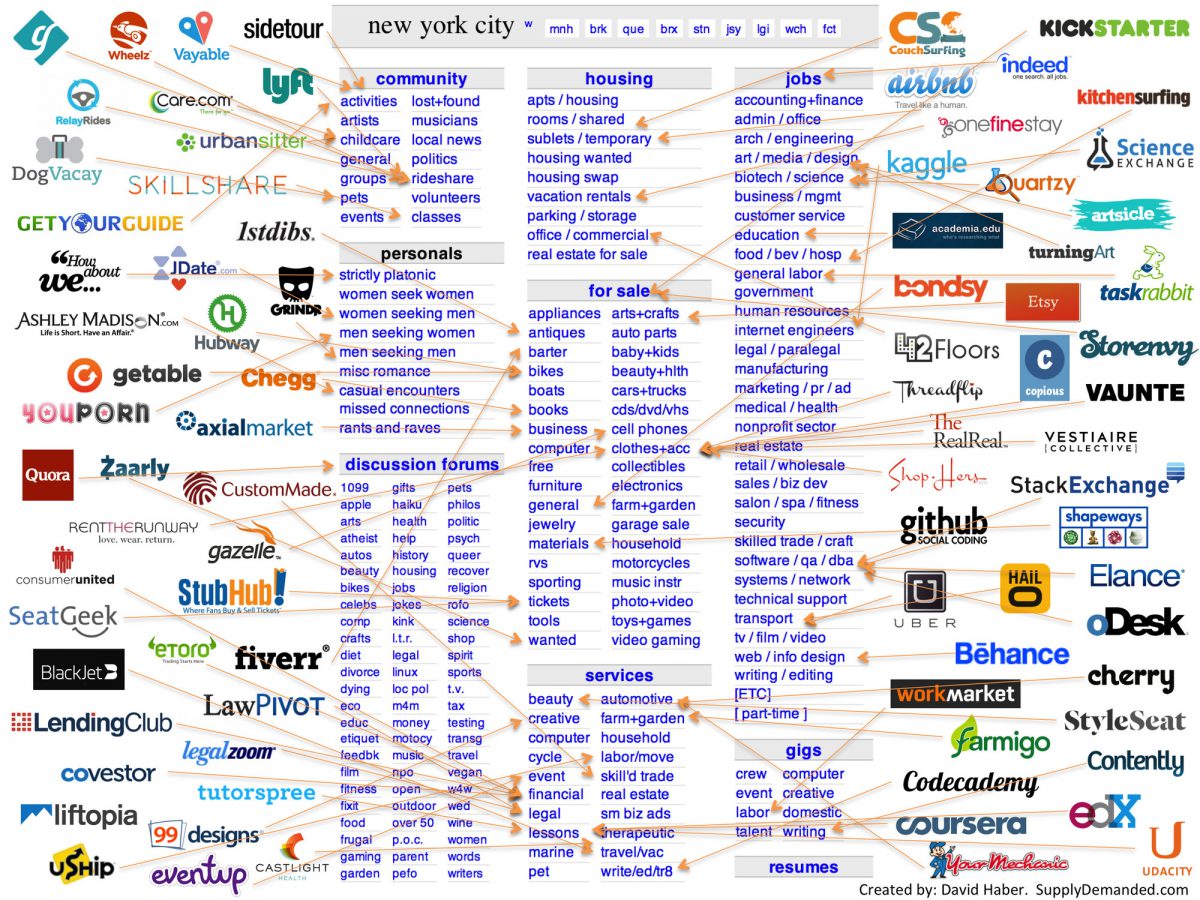As you know, I love operating and investing in marketplaces.
It’s been interesting over the years to observe which vertical marketplaces take off sustainably and which fizzle, especially in light of the two dominant horizontal liquidity behemoths: eBay and Craigslist.
For a while it looked like vertical sites would take away eBay’s business category after category as experts in each vertical with the right community credentials built something better attuned to the needs of that marketplace. Many such sites took off in verticals like high end guitars, audiophile equipment, etc. before fizzling away. Other sites like Stubhub, Airbnb and others built lasting vertical marketplaces.
Taking a step back it looks as though the categories that are best attackable have two characteristics:
1. Users purchase the product or service reasonably regularly.
The problem with the high end guitar site is that ultimately most people only buy such a guitar every few years. 5 years down the line, the buyer may not remember where he bought his guitar. As such the site has a hard time building a brand and must re-acquire the customer all over again leading to terrible unit economics. By comparison eBay and Craigslist are not acquiring customers for that one transaction because the buyer knows they can find the product there. By contrast people buy tickets to sports events, shows, etc. and go on vacation regularly enough to allow Stubhub and Airbnb to build established brands in the category through repeated interactions with the customers.
2. The vertical marketplace must offer something that is not easy for the horizontal marketplace to offer and truly improves transactions in the category.
The specialized guitar site launches with a better category tree than eBay and a more exhaustive list of guitar models. The problem is that this is not particularly distinctive. It’s easy for eBay to copy, not to mention there are thousands of experts willing to provide the information for very little. Likewise, horizontal classified sites can reasonably easily make sure they have the right attributes in real estate and cars making it hard for vertical sites to extract much value out of the categories. However, there are many categories whose specificity require specialized adjustments to the platform that will just never hit the technology development priority list of a horizontal site. Alternatively, they may require process changes that larger organizations are unwilling to do. In the case of tickets, users needed:
- Seating maps such that buyers would know where they were sitting and the view from there
- An authenticity guarantee to give buyers comfort the tickets were real.
The former would have required a fundamental design change to the way eBay product pages were designed. While the later required StubHub in the early days to take physical possession of the tickets to guarantee authenticity and in more recent times to establish relationships with venues to facilitate the exchange of etickets. This was a fundamental shift to the way eBay operated (never taking possession of the product) and could not work with eBay’s 10% commission. Not surprisingly it never hit eBay’s priority list. StubHub’s insight was that people were willing to pay much higher commissions in exchange for authenticity and a seating map – a commission more than high enough to cover the extra costs of guaranteeing the authenticity of the tickets.
Likewise, Airbnb realized that subletting rooms by the night on Craigslist was fraught with difficulty:
- It was hard to manage availability
- Organizing payments was difficult
- It’s hard to figure out if the host is reliable and truthful about the conditions of the apartment, while it’s hard for the host to figure out if the traveler is trustworthy and not going to trash the place (not to mention one party potentially raping and/or killing the other)
Airbnb addressed all those issues:
- They have a built in availability calendar
- They use the social graph and social proof to build trust
- They have reviews of hosts and travelers
- They intermediate the payment process
Users are more than willing to pay their 13% commission for the convenience (versus doing it for free on Craigslist). Given the relatively small size of vacation rentals or short term sublets on Craigslist and OLX, offering those 4 functions just for this category would not make sense. We considered it for a number of categories (e.g.; baby sitters), but given our current priorities it would not make the list before 2014 or 2015 at the earliest.
3. Market size:
I did not mention market size considerations because they are somewhat independent of whether a vertical marketplace can exist. There are many profitable niche businesses and marketplaces – they are just not relevant for us as investors and operators. You might think that each Craigslist or eBay category is niche, but the reality is that they can be huge niches. Vacation rentals (Airbnb’s business) is a $100 billion per year business globally for instance.
4. The Craigslist exception:
It’s become fashionable to think that Craigslist will die the death of a thousand cuts as hundreds of vertical sites take away their business (see: http://www.quora.com/Craigslist/Why-hasnt-another-product-disrupted-and-replaced-Craigslist).
The thinking is analogous to thinking that eBay would die because every category would be taken by specialized vertical sites – without consideration to the frequency of interaction or the real value added of the vertical site.
The argument may well pan out to be true, but for the wrong reason. It’s not that vertical sites are inherently better, it’s that Craigslist SUCKS. They don’t preapprove ads, they are not mindful of spam, scams and content quality. They don’t block illegal activity and prostitution. Their search engine is a joke. They are not improving their user experience or interface. As a result, while they are probably impossible to take on head on horizontally, they are vulnerable in almost every category.
This is not true internationally. In markets where the dominant horizontal classified site is a rational market actor (e.g.; Schibsted or OLX), the only opportunities that exist are those where there are repeat purchases and where the category needs something the horizontal site is not willing to offer.
5. Opportunities:
My dream job is to be the CEO of Craigslist. I am clearly the perfect man for the job and could prevent their obsolescence.
The plan would be to:
- Move all ads to pre-approval
- Deal more intelligently with scammers from Nigeria (e.g.; tell them their ad is live, give them the link but don’t show it to anyone else)
- Close personals (or more them to Craigsonals.org or something)
- Improve search
- Better support for pictures
- Stop charging for everything, but switch to Google Ads + Featured Ads + Bump Up
As you can imagine, given the personalities of Jim & Craig, I am not holding my breath.
a. Videdressing:
Of the marketplace ideas we have seen recently, I am particularly fond of Videdressing and recently invested in them. The category is worth around $100 billion per year globally. Videdressing’s main competitor is Vestiaire Collective, also based in France.
They both realized that for a fashion and luxury marketplace to take off they needed to offer protections against counterfeit. This allowed the category to take off in a way it could not on eBay or Craigslist (LeBonCoin in this case).
They have very different approaches to the market. Vestiaire Collective manually inspects all items after they are sold. Sellers ship the items to Vestiaire Collective who inspects them for quality issues and in the case of luxury goods – authenticity issues – and then ships them to the buyer. They currently have over 60,000 items on sale. The issue is that to support this approach they need to take a 30% commission which often translates into 20%-30% higher prices for the exact same products on their site versus Videdressing’s site and it takes up to 4 weeks for the buyer to receive an item.
Videdressing’s insight was that it could offer a better service with a more scalable model. Sellers ship items directly to buyers, thereby significantly decreasing delivery time. To guarantee authenticity, Videdressing uses experts in intellectual property law who are trained by the luxury houses to authenticate items based on pictures before the items are validated to be sold on the site. To bring additional reassurance to buyers in terms of authenticity and fit they combine this protection with an exclusive money back guarantee (which VestiaireCollective does not offer). As a result they now have 400,000 items on sale and can thrive with a 10% commission.
b. Other:
It’s worth pondering if other verticals are not worth going after. An information marketplace like Pearl.com could be a $100+ billion opportunity if done right. I wonder if a marketplace that only took 25% (instead of the 66% that Pearl takes) could not use the 36% commission to both give more money to experts and lower prices to consumers, making both sides happier. The problem is that Pearl.com already has liquidity while their approach has an inherently low net promoter score. I suspect that the better way to attack the market would be on the back of an existing free information marketplace that already has liquidity. Quora is probably best positioned to do so intelligently.
I am sure there are other large unexplored eBay and Craigslist verticals ripe for disintermediation. At times I even wonder if there is a successful head on Craigslist disruption play in the US given how bad the site is relative to where it could and should be.
Food for thought!



